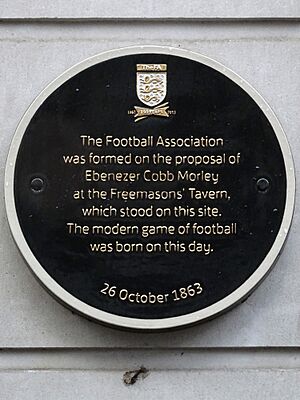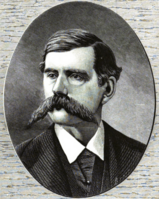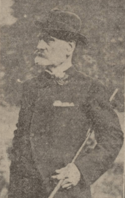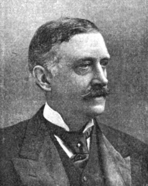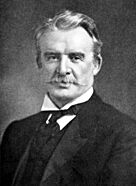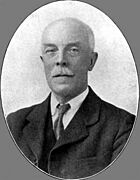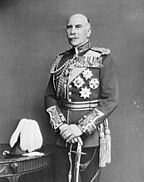The Football Association facts for kids
| UEFA | |
|---|---|
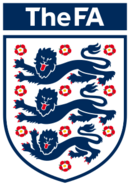 |
|
| Full name | Lua error in Module:Wd at line 1575: attempt to index field 'wikibase' (a nil value). |
| Short name | The FA |
| Founded | 26 October 1863 |
| Folded | Lua error in Module:Wd at line 1575: attempt to index field 'wikibase' (a nil value). |
| Headquarters | Wembley Stadium |
| Location | Wembley, London |
| FIFA affiliation |
|
| UEFA affiliation | 1954 |
| IFAB affiliation | 1886 |
| Patron | William, Prince of Wales |
The Football Association (also known as the FA) is the main organization that runs association football in England. It also looks after football in the Crown Dependencies like Jersey, Guernsey, and the Isle of Man. The FA started in 1863, making it the oldest football association in the world! It's in charge of both amateur and professional football in these areas.
The FA organizes all the big football matches in England. It also helps local football through smaller county associations. One of its most famous competitions is the FA Cup. The FA also chooses the coaches and managers for England's national football teams. This includes the men's, women's, and youth teams.
The FA is part of bigger football groups like UEFA (for Europe) and FIFA (for the world). It also has a special seat on the International Football Association Board (IFAB). This board helps create and change the Laws of Football. Because it was the first football association, it doesn't have "English" in its name. The FA's main office is at Wembley Stadium in London. The FA is also part of the British Olympic Association. This means it helps manage the men's and women's Great Britain Olympic football teams.
All professional football teams in England are members of the FA. While the FA doesn't run the daily operations of the Premier League, it has a say in important decisions. For example, it can approve or reject the league's chairman and changes to its rules. The English Football League, which includes the three professional divisions below the Premier League, also follows the FA's rules.
Contents
The FA's Story: How Football Began
Football as we know it today started in England. For many years before 1863, there were no clear rules for playing football. Different schools and clubs played with their own rules, which caused confusion. In 1862, a man named Ebenezer Cobb Morley suggested creating a group to make one set of rules.
This led to the first meeting of the Football Association. It happened on October 26, 1863, at the Freemasons' Tavern in London. Morley was one of the founding members. Over several meetings, they worked on creating common rules for the game.
Some schools, like University of Cambridge, had already tried to make their own rules, called the Cambridge Rules, in 1848. Another set, the Sheffield Rules, was used by clubs in northern England. The FA's goal was to bring everyone together under one set of rules.
Eleven London football clubs and schools joined the first meeting. Some of these were:
- Barnes
- Civil Service
- Crusaders
- Forest of Leytonstone (which later became Wanderers F.C.)
- N.N. (No Names) Club
- The original Crystal Palace
- The original Blackheath
- Kensington School
- Perceval House
- Surbiton F.C.
- Blackheath Proprietary School
Today, Civil Service F.C. is the only one of these original clubs that still plays association football without stopping since 1863.
Ebenezer Cobb Morley became the FA's first secretary and later its second president. He helped write the first official Laws of the Game, often called the "London Rules." He even played in the very first match using these new rules in 1863.
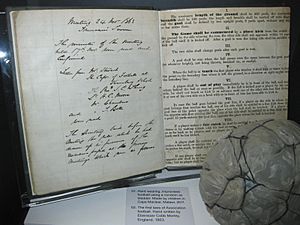
The first rules for modern football were created during six meetings from October to December 1863. Some clubs left, and new ones joined, like the Royal Navy School and Forest School.
Football and Rugby Go Their Separate Ways
At the last meeting, some clubs disagreed with the new rules. They wanted to keep rules that allowed running with the ball in hand and tackling opponents by kicking their shins (called "hacking"). Because these rules were removed, Blackheath and other clubs left the FA.
These clubs then formed their own group in 1871, called the Rugby Football Union. This is how football split into two main sports: association football (which we call "soccer") and rugby football. The word "soccer" actually comes from "association."
The first game using the new FA rules was played on December 19, 1863. Morley's Barnes team played against Richmond. It was a 0-0 draw. Richmond wasn't happy with the new rules and later helped form the Rugby Football Union. The first public game under FA rules was on January 9, 1864, at Battersea Park. After this game, people toasted "Success to football, irrespective of class or creed."
In 1866, a special match was played between a team from London (representing the FA) and Sheffield FC. This game was important for showing how the new FA rules worked.
C. W. Alcock became the FA's first full-time secretary in 1870. He was the person who came up with the idea for the FA Cup in 1871. The FA Cup is the oldest football competition in the world! Clubs paid money to buy a trophy. The first FA Cup Final was held on March 16, 1872, between Wanderers and the Royal Engineers. About 2,000 people watched the game.
One Set of Rules for Everyone
For many years, the London-based FA and the Sheffield Football Association had different rules. But the FA Cup helped everyone agree that one set of rules was needed. In April 1877, the rules were finally set, including some from the Sheffield Rules.
At first, the FA Cup was mostly played by amateur teams from the south of England. But in the early 1880s, professional teams from the north started to win. These northern teams, like Blackburn Olympic and Blackburn Rovers, used new passing styles from Scotland and trained more professionally.
The FA first tried to stop players from being paid, but professional football was becoming too popular. By 1885, the FA had to allow players to be paid. Three years later, in 1888, the first Football League was created. It had 12 professional clubs from different parts of England.
In 1992, the FA helped create the Premier League. This league started with 22 clubs that left the Football League's top division. The Premier League later became 20 clubs in 1995 and is now one of the richest football leagues in the world.
The FA has changed its logo over the years. For its 150th birthday in 2013-2014, they used a special gold logo.
Women's Football and the FA
Women's football became very popular during and after the First World War. Women's teams played charity games, and sometimes more people watched their matches than men's games! However, in 1921, the FA banned women's teams from playing on grounds linked to the FA. They thought football was bad for women's bodies. This ban meant women's football almost disappeared for many decades.
The FA's ban on women's football was finally lifted in 1969. This happened after England won the 1966 World Cup, which made more people interested in football. The Women's Football Association was formed. It took two more years, and an order from UEFA, for the FA to fully remove its restrictions on women's teams.
It wasn't until 1983 that the Women's Football Association officially joined the FA. In 1993, the FA created the "Women's Football Committee" to manage women's football in England. This committee, now called the "Women's Football Conference," has a voice on the FA Council, just like a county football association.
Football Achievements
The FA oversees the success of England's national football teams in major tournaments.
Men's National Team Achievements
- FIFA World Cup
- UEFA European Championship
- UEFA Nations League
- Third place (1): 2019
- Olympic Games
- Gold medal (3): 1900, 1908, 1912
Women's National Team Achievements
- FIFA Women's World Cup
- UEFA European Women's Championship
- Winners (2): 2022, 2025
- Runners-up (2): 1984, 2009
- Women's Finalissima
- Winners (1): 2023
Youth National Team Achievements
Men's Youth Teams
- FIFA U-20 World Cup
- Winners (1): 2017
- FIFA U-17 World Cup
- Winners (1): 2017
- UEFA U-21 Championship
- Winners (4): 1982, 1984, 2023, 2025
- UEFA U-19/18 Championship
- Winners (11): 1948, 1963, 1964, 1971, 1972, 1973, 1975, 1980, 1993, 2017, 2022
- UEFA U-17/16 Championship
- Winners (2): 2010, 2014
Women's Youth Teams
- FIFA U-20 Women's World Cup
- Third place (1): 2018
- FIFA U-17 Women's World Cup
- Fourth place (1): 2008
- UEFA Women's U-19 Championship
- Winners (1): 2009
- UEFA Women's U-17 Championship
- Semi-finals/Third place (2): 2016, 2023
Changes and Improvements at the FA
In April 2017, the FA made some important changes to how it works. These changes included:
- Adding three positions on the FA board for women by 2018.
- Making the board smaller, with only 10 members.
- Adding 11 new members to the FA Council to make it more diverse and include different voices from English football.
- Limiting how long people can serve on the board and council.
These changes were made to help the FA become more modern and fair.
Football in Crown Dependencies
The football associations in Jersey (Jersey Football Association), Guernsey (Guernsey Football Association), and the Isle of Man (Isle of Man Football Association) are connected to the FA. Even though these islands are not part of the United Kingdom, their football groups are like "county football associations" to the FA. Famous players like Matt Le Tissier and Graeme Le Saux, who played for England, were born in Guernsey and Jersey.
These island football associations have been linked to the FA for a long time. Guernsey joined in 1903, the Isle of Man in 1908, and Jersey in 1905.
Football in Overseas Territories
Gibraltar's football association (Gibraltar Football Association) was part of the FA until 2008. Then, it decided to become a full member of UEFA, which took a long legal fight.
The Hong Kong Football Association (HKFA), started in 1914, is one of the oldest in Asia. It joined FIFA in 1954 and was a founding member of the Asian Football Confederation (AFC). Hong Kong played a big part in early Asian football and hosted the first Asian Cup in 1956. Hong Kong was handed over to China in 1997.
Some other British overseas territories also have their own football groups or leagues. These include places like Anguilla, Bermuda, and the Cayman Islands. These groups are not part of the Football Association in England.
Even though these territories are small, they have produced talented players like Clyde Best. He went on to play professionally in England. They also have referees who have worked in FIFA matches.
The FA and FIFA: A Long History
The Football Association first joined FIFA in 1905. However, the British football associations (England, Ireland, Scotland, and Wales) left FIFA after World War I. They didn't want to be part of an organization that included countries from the Central Powers. They rejoined FIFA in 1924.
The FA left FIFA again in 1928. This was because FIFA decided to allow players to be paid for time off work when playing in the Olympics. The FA disagreed with this rule. Because of this, England did not play in the 1930, 1934, or 1938 World Cups.
The FA rejoined FIFA in 1946. England then played in its first World Cup in 1950. One of the FA's first actions was to ask for Germany and Japan to be removed from FIFA because of their roles in World War II. These countries were not allowed to play in the 1950 World Cup. They rejoined FIFA in 1950.
Football Competitions Run by The FA
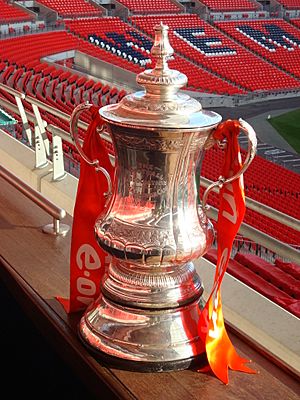
The FA organizes many different football competitions:
Current Competitions
- FA Cup
- FA Trophy
- FA Vase
- Women's FA Cup
- FA Women's League Cup
- FA Women's National League Cup
- FA Women's National League Plate
- FA Youth Cup
- FA Sunday Cup
- FA County Youth Cup
- FA Community Shield
- Women's FA Community Shield
- FA Inter-League Cup
- FA Futsal Cup
- FA People's Cup
Past Competitions
- FA Umbro Fives
How The FA Works: Money and Leadership
FA Finances
The FA makes most of its money from selling the rights to show England's international matches and the FA Cup games on TV. This is their biggest source of income.
For example, from 2008 to 2012, the FA earned £425 million from TV rights in the UK and £145 million from overseas TV rights. In 2016, the FA made £370 million and put £125 million back into football at all levels. The FA also supports five different charities each year.
The FA has also fined players for comments they made on social media. For instance, in three years up to 2014, the FA collected £350,000 in fines from players for comments on Twitter.
FA Leaders
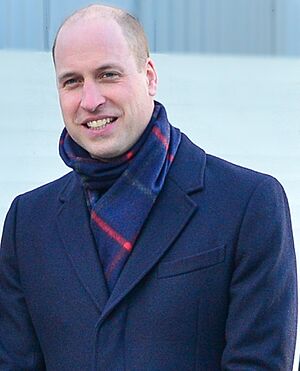
The FA has a special role called the President, who is usually a member of the British royal family. The Chairman of the FA is in charge of the main plans and decisions. The daily operations of the FA are managed by the Chief Executive.
| Role | Name | Years in Role |
|---|---|---|
| President | Arthur Pember | 1863–1867 |
| E. C. Morley | 1867–1874 | |
| Francis Marindin | 1874–1890 | |
| Lord Kinnaird | 1890–1923 | |
| Sir Charles Clegg | 1923–1937 | |
| William Pickford | 1937–1939 | |
| The Earl of Athlone | 1939–1955 | |
| The Duke of Edinburgh | 1955–1957 | |
| The Duke of Gloucester | 1957–1963 | |
| The Earl of Harewood | 1963–1971 | |
| The Duke of Kent | 1971–2000 | |
| The Duke of York | 2000–2006 | |
| The Prince of Wales | 2006–2024 | |
| Vice President | Charles Crump | 1886–1923 |
| Chairman | Charles Clegg | 1890–1937 |
| A. G. Hines | 1938 | |
| M. Frowde | 1939–1941 | |
| Sir Amos Brook Hirst | 1941–1955 | |
| Arthur Drewry | 1955–1961 | |
| Graham Doggart | 1961–1963 | |
| Joe Mears | 1963–1966 | |
| Sir Andrew Stephen | 1967–1976 | |
| Sir Harold Thompson | 1976–1981 | |
| Bert Millichip | 1981–1996 | |
| Keith Wiseman | 1996–1999 | |
| Geoff Thompson | 1999–2008 | |
| The Lord Triesman | 2008–2010 | |
| David Bernstein | 2011–2013 | |
| Greg Dyke | 2013–2016 | |
| David Gill | 2016 (interim) | |
| Greg Clarke | 2016–2020 | |
| Peter McCormick | 2020–2022 (interim) | |
| Debbie Hewitt | 2022–present | |
| Secretary | E. C. Morley | 1863–1866 |
| R. W. Willis | 1866–1867 | |
| R. G. Graham | 1867–1870 | |
| C. W. Alcock | 1870–1895 | |
| Sir Frederick Wall | 1895–1934 | |
| Sir Stanley Rous | 1934–1962 | |
| Denis Follows | 1962–1973 | |
| Ted Croker | 1973–1989 | |
| Chief Executive | Graham Kelly | 1989–1998 |
| Executive Director | David Davies | 1998–2000 |
| Chief Executive | Adam Crozier | 2000–2002 |
| David Davies | 2002–2003 (acting) | |
| Mark Palios | 2003–2004 | |
| David Davies | 2004–2005 (acting) | |
| Brian Barwick | 2005–2008 | |
| Ian Watmore | 2009–2010 | |
| Alex Horne | 2010 (acting) | |
| Martin Glenn | 2015–2019 | |
| Mark Bullingham | 2019–present | |
| General Secretary | Alex Horne | 2010–present |
The FA Board of Directors
As of January 9, 2022, the FA's Board of Directors includes:
- Chairwoman: Debbie Hewitt
- Chief Executive: Mark Bullingham
- National Game Representatives: Sue Hough, Jack Pearce, Thura Win
- Professional Game Representatives: Peter McCormick, Rick Parry, Rupinder Bains
- Independent Non-Executive Directors: Kate Tinsley, Tim Score
- Board Observers: Paul Elliott, David Gill
See also
 In Spanish: Asociación Inglesa de Fútbol para niños
In Spanish: Asociación Inglesa de Fútbol para niños


